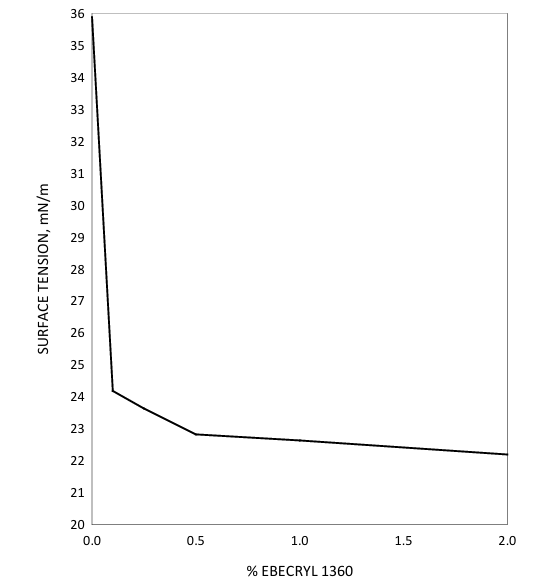Enhanced TDS
Identification & Functionality
- Blend
- No
- CASE Ingredients Functions
- Carrier
- Chemical Family
- Country of Origin
- Product Code
- MITM00353
- Single Ingredient
- Yes
- Technologies
- Product Families
Features & Benefits
- CASE Ingredients Features
- Labeling Claims
- Performance Highlights
EBECRYL® 1360 is characterized by:
- Low surface tension
- Low viscosity
- High functionality
- Non-migratory
UV/EB cured products containing EBECRYL® 1360 are characterized by the following performance properties:
- Reduced COF, increased slip
- Resistance to blocking
- High gloss
- Good mar resistance
- Non-migratory
The actual properties of UV/EB cured products also depend on the selection of other formulation components such as reactive diluents, additives and photoinitiators.
Applications & Uses
- Application Method
- Coating End Applications
- Compatible Substrates & Surfaces
- Cure Method
- Markets
- Applications
- Product Applications
Formulated UV/EB curable products containing EBECRYL® 1360 may be applied via direct or reverse roll, offset gravure, metering rod, slot die, knife over roll, air knife, immersion and spin coating methods as well as screen printing.
EBECRYL® 1360 is recommended for use in:
- Overprint varnishes
- Clear coatings on paper, plastics and metal
- Release coatings
- EB cure
Properties
- Physical Form
Technical Details & Test Data
- Effect on the Surface Tension of Tmpta
The following graph illustrates the change in surface tension that occurs when increasing amounts of EBECRYL® 1360 are added to TMPTA

Packaging & Availability
Principal Information
- Group Principal Number
- S000001
- Principal
Storage & Handling
- Storage Conditions
- Care should be taken not to expose the product to high temperature conditions, direct sunlight, ignition sources, oxidizing agents, alkalis or acids.
- This might cause uncontrollable polymerization of the product with the generation of heat.
- Storage and handling should be in stainless steel, amber glass, amber polyethylene or baked phenolic lined containers.
- Procedures that remove or displace oxygen from the material should be avoided.
- Do not store this material under an oxygen free atmosphere.
- Dry air is recommended to displace material removed from the container.
- Wash thoroughly after handling.
- Keep container tightly closed.
- Use with adequate ventilation.
- EBECRYL® 1360 may exhibit crystallization if subjected to temperatures below 15°C.
- This crystallization can be removed by heating containers of EBECRYL® 1360 to a uniform temperature of 40°C.
- Ovens or hotboxes are recommended methods of heating.
- Heating bands or blankets should not be used.
Other
- Appearance
- Cloudy liquid
- Appearance (SDS)
- Liquid
- Color (SDS)
- Dark amber
- Insoluble in (SDS)
- Water
- Item Number
- Odor (SDS)
- Ester acrylate
- Other Hazards
- Polymerization may occur from excessive heat ,contamination or exposure to direct sunlight , Contact with skin may cause a cross-allergic reaction in persons already sensitized to acrylates.
- Protect from Freezing
- Yes
- Temperature Control
- Yes
- USA/DOT UN Number
- Not Applicable
- Application Information
Value Units Test Method / Conditions Dosage (Use Level) 0.5-2.0 %(W/W) %(W/W) - Chemical Properties
Value Units Test Method / Conditions Acid Value max. 25.0 mg KOH/g mg KOH/g - Material Composition
Value Units Test Method / Conditions Oligomer Content 100.0 %(W/W) %(W/W) - Optical Properties
Value Units Test Method / Conditions Color Scale max. 12.0 Gardner Gardner Gardner Color Scale - Physical Properties
Value Units Test Method / Conditions Density 1.11 g/mL g/mL at 25°C Storage Temperature 59.0-104.0 °F °F Surface Tension 22.4 mN/m mN/m Viscosity 750.0-3100.0 mPa.s mPa.s at 25°C - SDS Physical and Chemical Properties
Value Units Test Method / Conditions Boiling Point (SDS) min. 100.0 °C °C Density (SDS) 1.11 g/cm³ g/cm³ Flash Point (SDS) 224.0 °C °C Cleveland Open Cup Vapor Pressure (SDS) max. 1.33 hPa hPa at 20°C Volatile Content (SDS) max. 1.0 % % - Shelf Life & Stability
Value Units Test Method / Conditions Shelf Life 0.0 d d
